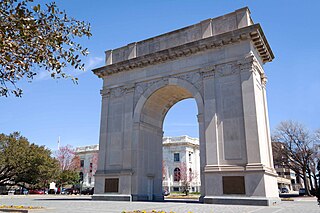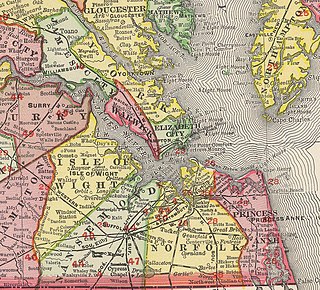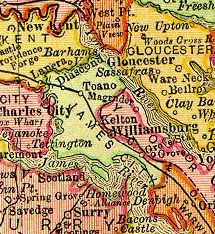Related Research Articles

York County is a county in the eastern part of the Commonwealth of Virginia, located in the Tidewater. As of the 2020 census, the population was 70,045. The county seat is the unincorporated town of Yorktown.

Newport News is an independent city in southeastern Virginia, United States. At the 2020 census, the population was 186,247. Located in the Hampton Roads region, it is the fifth-most populous city in Virginia and 140th-most populous city in the United States. The city is at the southeastern end of the Virginia Peninsula, on the northern shore of the James River to the river's mouth on the harbor of Hampton Roads.

James City County is a county located in the Commonwealth of Virginia. As of the 2020 census, the population was 78,254. Although politically separate from the county, the county seat is the adjacent independent city of Williamsburg.

The Virginia Peninsula is located in southeast Virginia, bounded by the York River, James River, Hampton Roads and Chesapeake Bay. It is sometimes known as the Lower Peninsula to distinguish it from two other peninsulas to the north, the Middle Peninsula and the Northern Neck.

Warwick County was a county in Southeast Virginia that was created from Warwick River Shire, one of eight created in the Virginia Colony in 1634. Located on the Virginia Peninsula on the northern bank of the James River between Hampton Roads and Jamestown, the area consisted primarily of farms and small unincorporated villages until the arrival of the Peninsula Extension of the Chesapeake and Ohio Railway in 1881 and development led by industrialist Collis P. Huntington.

Warwick River Shire was one of eight shires created in colonial Virginia in 1634. It was located on the Virginia Peninsula on the northern shore of the James River between Hampton Roads and the Jamestown Settlement.

Grove is an unincorporated community in the southeastern portion of James City County in the Virginia Peninsula subregion of Virginia in the United States. It is located in the center of the Historic Triangle of Colonial Virginia, communities linked by the Colonial Parkway. This area is one of the busiest tourist destinations in the world.

Lee Hall is a community located in the extreme northern portion of the independent city of Newport News in the Commonwealth of Virginia in the United States.
Richneck Plantation was a property in colonial Virginia, located on the Virginia Peninsula on the northern shore of the James River between Hampton Roads and Jamestown. The Richneck manor house's foundation was discovered during construction of the George J. McIntosh elementary school, and became an archeological dig, then listed on the National Register of Historic Places.

U.S. Route 60 (US 60) in the Commonwealth of Virginia runs 303 miles (488 km) west to east through the central part of the state, generally close to and paralleling the Interstate 64 corridor, except for the crossing of the Blue Ridge Mountains, and in the South Hampton Roads area.

Morrison was a small unincorporated community in Warwick County, Virginia. After a municipal consolidation in 1958, it became a neighborhood of the independent city of Newport News.
Captain Samuel Mathews was a Virginia planter, political figure, and the father of Governor Samuel Mathews. Also known as Colonel Mathews, the elder Samuel became one of the most prominent men in the colony.

Newport News has a long history dating back to the days of Jamestown, Virginia. The area which is now the city of Newport News has existed under different names and forms including Elizabeth Cittie, Warwick River Shire, Warwick County, Virginia, Warwick City, and the current independent city of Newport News.
Lt. Col. Samuel Mathews (1630–1660), Commonwealth Governor of Virginia, of Warwick County in the English Colony of Virginia, was a member of the House of Burgesses, the Governor's Council, and served as Commonwealth Governor of Virginia from 1656 until he died in office in January 1660. There was no Royal Governorship at the time of the "Protectorate", and the Governor technically answered to the Cromwellian Parliament, although Royalist sentiment was prevalent in the colony of Virginia at this time. The former Royalist governor Berkeley arrived to replace him on March 13, 1660.
Hidenwood is a neighborhood in the independent city of Newport News, Virginia which is located off Warwick Boulevard just west of the campus of Christopher Newport University (CNU).

Warwick County Courthouses, also known as the Warwick County Courthouse and Clerk's Office, is a historic courthouse and clerk's office located in Newport News, Virginia.

Denbigh Plantation, also known as Mathews Manor, is a historic archaeological site located at Newport News, Virginia.

First Denbigh Parish Church Archeological Site is a historic archaeological site located at Newport News, Virginia. The site is located on the bluff overlooking the Warwick River at the mouth of Church Creek. It took its name from nearby Denbigh Plantation and was constructed in 1636.
William Digges was a planter and politician in the Colony of Virginia, who represented Warwick County, Virginia in the House of Burgesses from 1752 until 1771.
References
- ↑ "Denbigh Parish". The Historical Marker Database.
- ↑ "Framework for the Future 2030 - Appendix - Historic Sites". Archived from the original on June 19, 2009. Retrieved April 7, 2017.
